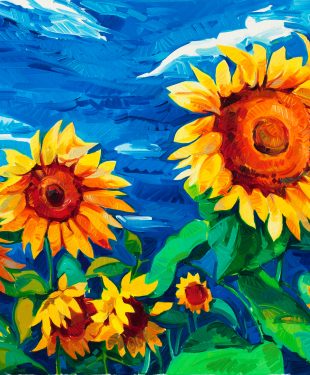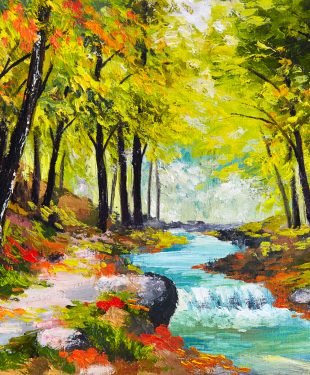Oil Painting Tips
Oil painting is an art form that allows you to bring your artwork to life with rich, vibrant hues and captivating textures. To help you on your artistic journey, we’ve gathered a treasure trove of oil painting tips from experienced professionals. These essential techniques will enhance your skills and ensure your participation in the online art competitions leaves a lasting impression.
Tip 1: Invest in Quality Colors and Save Canvases
The foundation of any masterpiece is quality materials. Invest in high-quality oil paints and brushes. Professional-grade supplies ensure vibrant colors, smooth application, and lasting results, essential for creating that stand out. While many artists prefer linen canvases, you can save on costs by preparing your canvases with super heavy gesso on birch wood. This alternative provides texture similar to linen and allows you to allocate your budget to top-quality paints that help you in your online art competition.
Tip 2: Plan Your Composition
Before you even touch your canvas, spend time planning your composition. Consider the rule of thirds, leading lines, and focal points to create a balanced and engaging layout. A thoughtful composition will draw viewers to your artwork in online art competitions.
Tip 3: Start with Underpainting
One of the common challenges in oil painting is the blending of wet layers of paint. To overcome this, consider using fast-drying white or underpainting white. This special white paint, thicker than standard titanium white, allows you to paint over layers without frustratingly mixing colors.
Tip 4: Mastering the Art of Thin Lines in Oil Painting
 Creating fine lines with wet oil paints for colorful paintings can be tricky due to the medium’s thickness. You can use a business card to tap thin lines onto your artwork or experiment with acrylics over dry oils to achieve thin lines. Utilize oil pastels with Liquin for line work on your vibrant animal paintings. Many pieces in some of the best international art galleries across the world were created with this trick.
Creating fine lines with wet oil paints for colorful paintings can be tricky due to the medium’s thickness. You can use a business card to tap thin lines onto your artwork or experiment with acrylics over dry oils to achieve thin lines. Utilize oil pastels with Liquin for line work on your vibrant animal paintings. Many pieces in some of the best international art galleries across the world were created with this trick.
Tip 5: Tone Your Canvas for Added Benefits
Toning your canvas, a practice often seen in top galleries, offers several advantages for artists. This technique can help balance glare during plein air painting for your paintings. Create subtle texture, enhance color variety, and add a warm glow to your work.
Tip 6: Creating Texture with Dry Brushing
When painting animals, textures are crucial for realistic depictions. Dry brushing allows you to indicate various textures, like fur or features. By lightly dragging your brush over the canvas, you can create textures that make your subjects come alive, enhancing the quality of your online art competition submissions.
Tip 7: Vary Colors for Added Interest
Creating variety in color is essential for lively animal paintings. Monochromatic colors can be dull, so try this oil painting tip: mix colors partially on your palette, neutralizing their saturation. Load your brush and apply gentle pressure, allowing subtle color variations to appear in each stroke. This technique brings your subjects to life and engages your artwork, whether it hangs in your home or an international art gallery.
Tip 8: Conveying Volume with Thick Paste
 For vibrant animal subjects that pop from your canvas, utilize thick impasto. Start with a thick application of paint in the foreground and gradually reduce thickness as you move into the background. This technique adds three-dimensional depth and brings your animal subjects to life, making them stand out in your online art competition entries.
For vibrant animal subjects that pop from your canvas, utilize thick impasto. Start with a thick application of paint in the foreground and gradually reduce thickness as you move into the background. This technique adds three-dimensional depth and brings your animal subjects to life, making them stand out in your online art competition entries.
Tip 9: Practice Patience
Masterpieces aren’t created overnight. Oil painting is a slow-drying medium, and professionals stress the importance of patience. Allow layers to dry before adding more, and be prepared for revisions. The time and effort you invest will reflect in the quality of your art, making it more competitive in online art competitions.
Tip 10: Blend with Fingers for Precise Edges
Overcome your fear of using your fingers in oil painting. The tactile nature of fingers allows for precise blending and smudging, especially when you need to get edges just right. It is a valuable technique for artists aiming to create vivid, colorful paintings that capture the subject’s essence.
Final Piece
Incorporate these 10 oil painting tips into your creative process and watch your animal painting come to life with vibrancy and depth. Whether you are a graffiti artist or participating in online art competitions or simply honing your skills, these pro tips will help your artwork truly speak to viewers. Happy painting!
Read more art articles at ClichéMag.com
Images provided by Deposit Photos, BingAI, Adobe Stock, Unsplash, Pexels, Pixabay & Creative Commons



